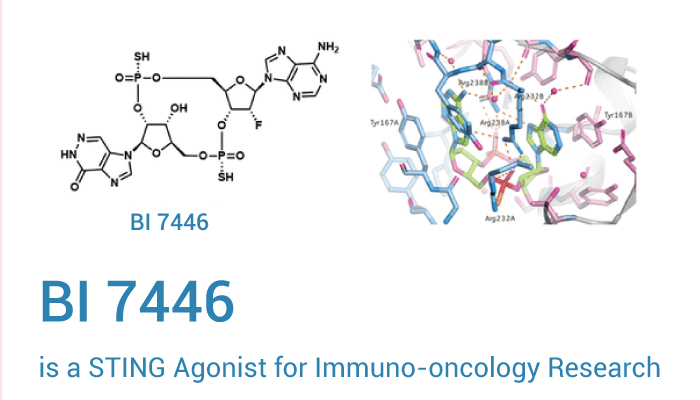STING, refers to the stimulator of interferon genes, is an endoplasmic reticulum (ER) membrane-bound adapter protein. It binds to cGAMP and send a dramatic conformational change. Thereby STING triggers itself translocation from the ER to the perinuclear Golgi apparatus. This process simultaneously recruits downstream effectors to generate an antitumor immune response, such as TBK1, IRF3, and so on. STING agonists are available for anti-cancer research as monotherapy or in combination with anti-PD-1 antibodies. It has miraculous effects on patients refractory to single-agent anti-PD-1 therapy. Here we introduce a STING agonist based on 2′,3′-cGAMP, BI 7446.

BI 7446 contains a cGAMP structure with significant anti-tumor potency.
Firstly, BI 7446 derived from 2′,3′-cGAMP, a cyclic dinucleotide (CDN), has activity targeting a broad spectrum of STING variants. It targets five STING haplotypes with EC50s of 0.54 μM (WT), 0.64 μM (HAQ), 6.11 μM (REF), 0.61 μM (AQ), 7.98 μM (Q), >50 μM (KO), respectively. Moreovre, BI 7446 exerts a direct cytotoxic effect on cancer cells, with an EC50 of 0.06 μM on THP1 cells. Meanwhile, it (3 μM, 10 μM; 6 h) increases the phosphorylation levels of IRF3 and TBK1 in THP1 WT cells, indicating that it regulates immune responses.
BI 7446 has cross-species activity against mouse RAW cell line (EC50=4.8 μM). PK results in BALB/c mice (10 μmol/kg; IV) showed that it has high plasma clearance (78% for CLPlasma) and short half-life. It (0.25, 1, 4 μg, sc, once a week) induces durable tumor regression in EMT breast cancer model mice and can generate long-term immune memory to resist autologous tumor rechallenge.
In summary, BI 7446 is a potent STING agonist that targets STING through a cyclic dinucleotide structure to inhibit tumors.
Reference:
Kuttruff CA, et al. J Med Chem. 2023 Jul 27;66(14):9376-9400.